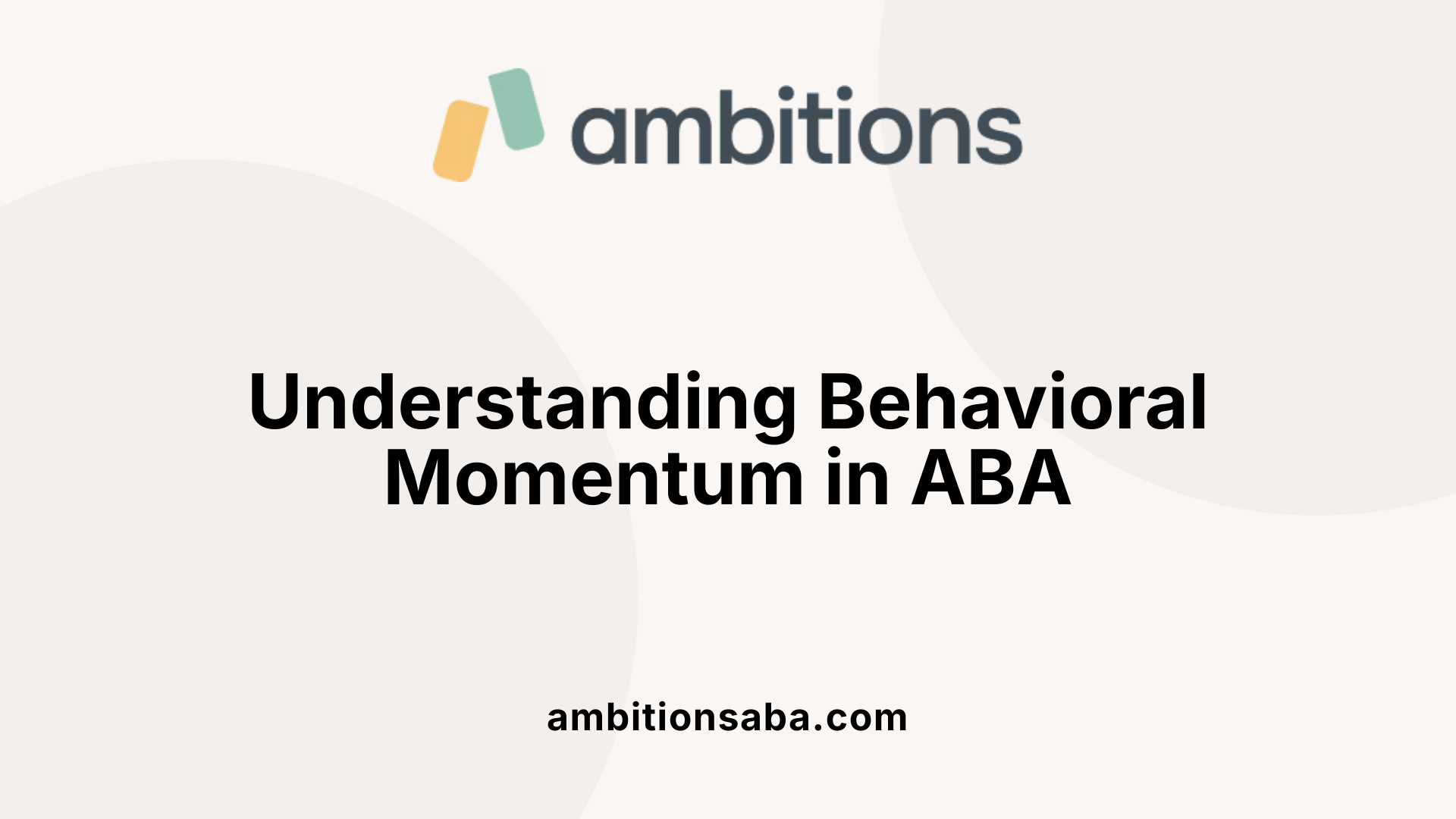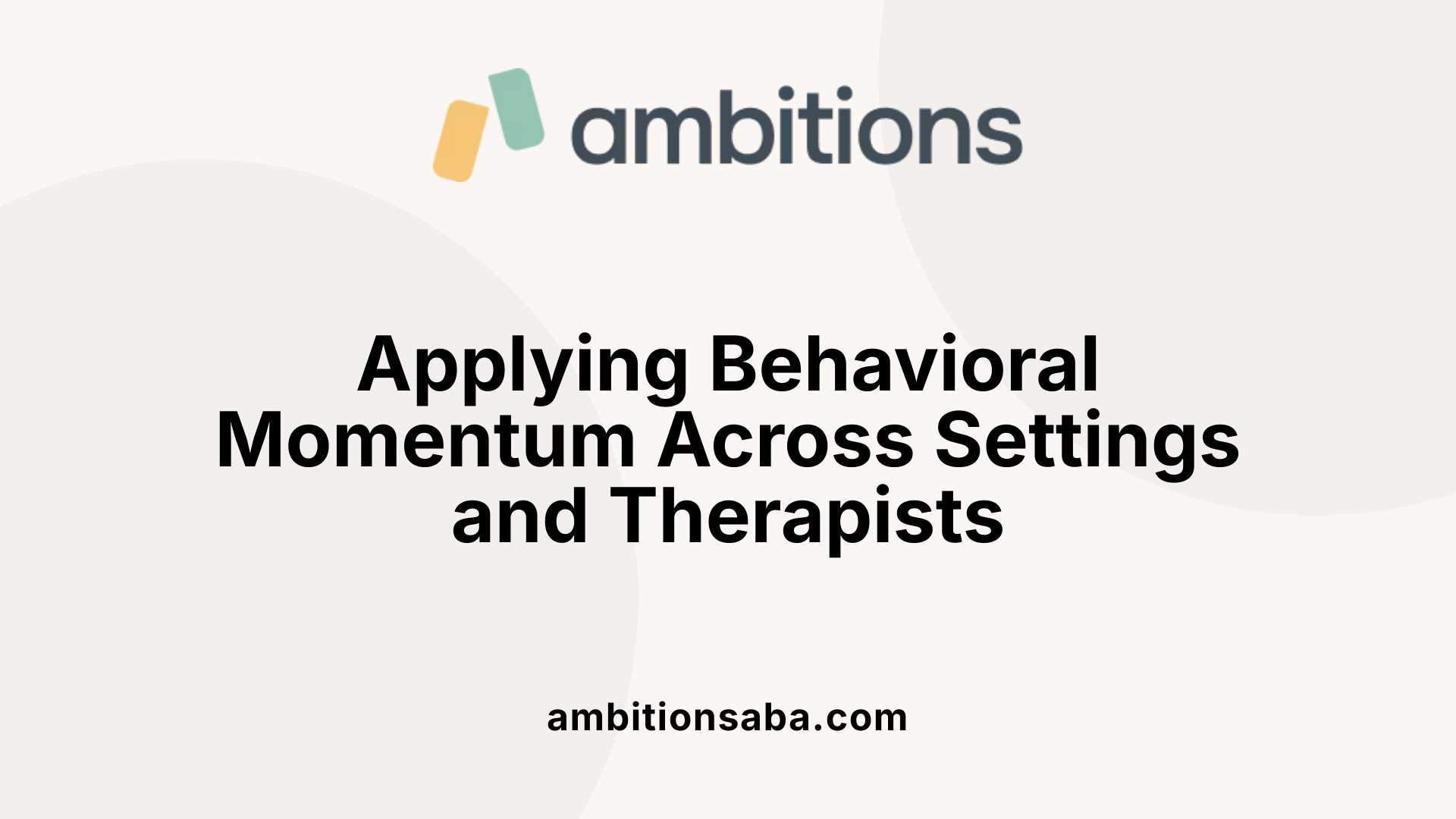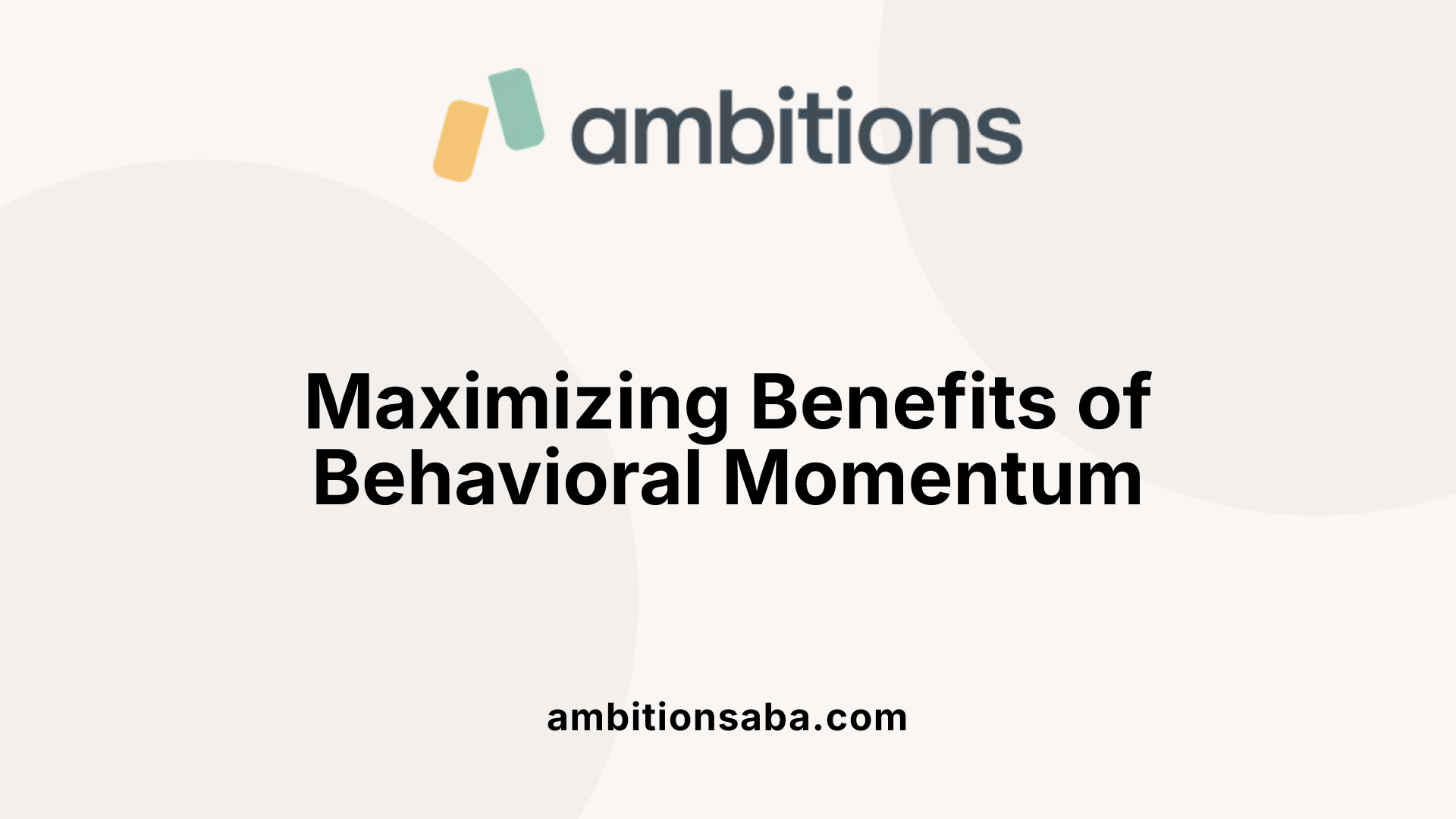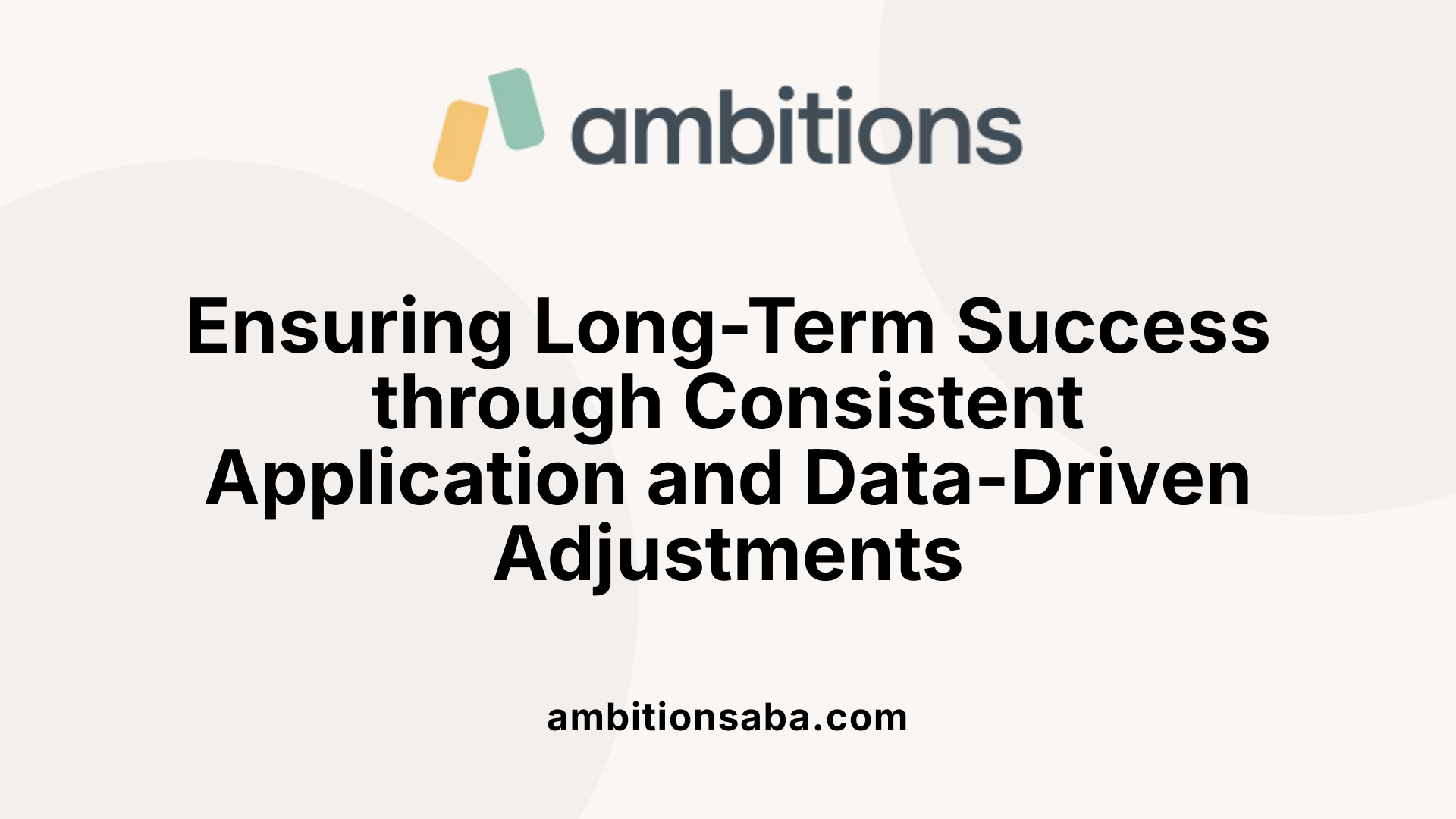Introduction to Behavioral Momentum in ABA
Behavioral momentum is an essential strategy within Applied Behavior Analysis (ABA) that enhances the likelihood of compliance and engagement among learners, especially those with developmental or behavioral challenges. By understanding and applying the principles of behavioral momentum, therapists and caregivers can foster more effective learning environments, reduce resistance, and promote positive behavior change. This article explores the concept, scientific basis, practical applications, benefits, and considerations associated with behavioral momentum in ABA, providing a comprehensive overview for practitioners, educators, and families.
Defining Behavioral Momentum in ABA

What is behavioral momentum in ABA?
Behavioral momentum is a technique used within Applied Behavior Analysis (ABA) to enhance compliance, motivation, and overall engagement in individuals, particularly children with autism spectrum disorder. The core idea is to start with simple, high-probability requests—tasks the individual is very likely to accomplish successfully—to establish a pattern of success. These easy tasks serve as a foundation for building momentum toward more challenging or less preferred behaviors.
The strategy involves presenting several of these high-probability requests in rapid succession, ensuring the individual receives immediate reinforcement—such as praise, access to preferred objects, or other rewards—after each successful response. Once a positive momentum is established through repeated successes, the therapist or caregiver then introduces a low-probability or more difficult request. Thanks to the established momentum, the individual is more likely to comply with this less preferred task.
Research supports this approach, demonstrating that persistence and compliance increase significantly when high-probability behaviors precede low-probability demands (Davis, C.A., Brady, M.P., Williams, R.E., & Hamilton, R., 1992). This technique leverages the natural tendency for behaviors that are reinforced consistently to become more resistant to change, thus making it easier to teach new skills or encourage compliance with challenging behaviors.
By systematically increasing the likelihood of task completion through successive successes, behavioral momentum helps turn potentially resistant behaviors into positive learning opportunities. It is often used to ease transitions, respond to unexpected requests, and reduce escape-maintained or disruptive behaviors.
Overall, behavioral momentum provides a strategic framework for building confidence, increasing cooperation, and fostering skill development. Its effectiveness relies on pinpointing responses that the individual is likely to do, delivering prompt reinforcement, and transitioning smoothly from easy to more difficult tasks. This approach creates a positive cycle of success that enhances learning and generalization across settings.
The Theoretical Foundation of Behavioral Momentum
Physics analogy and scientific principles
Behavioral momentum borrows its conceptual foundation from Newton's second law of motion, which explains how objects resist changes in their movement when subjected to external forces. In the context of behavior analysis, this analogy describes how behaviors tend to persist or resist change in the face of disruptions or environmental alterations.
The idea is that behaviors reinforced at high rates and with consistent reinforcement develop a sort of 'behavioral mass,' making them more resistant to interruption. Just as a heavy object resists a push, behaviors with strong reinforcement histories tend to continue even when conditions change, such as during the implementation of interventions or in distracting environments.
This physical metaphor helps us understand why some behaviors are more persistent than others. For example, behaviors that have been reinforced frequently and across various contexts are more likely to resist extinction or resistance.
Resistance to change and response persistence
Response persistence, or resistance to change, is a core component of behavioral momentum theory. It explains why behaviors that are well-established through reinforcement can persist despite attempts to modify or eliminate them.
In applied settings, this means that behaviors reinforced regularly during high-probability request sequences (easy tasks the learner is likely to comply with) will be more likely to continue when attempting to introduce more challenging or less preferred behaviors.
This resistance is beneficial in therapy because it allows clinicians to build confidence and compliance gradually. It also helps in maintaining desirable behaviors and reducing maladaptive responses.
Mathematical models and equations
Behavioral momentum theory has been formalized through mathematical models that quantify resistance to change. These models describe how reinforcement rates and the frequency of responses influence behavior persistence.
A basic equation in behavioral momentum theory demonstrates that the resistance to change (\
Application in Therapy and Settings

How can behavioral momentum be applied in ABA therapy?
In ABA therapy, behavioral momentum is used as a strategic tool to increase compliance and motivation. The core idea involves starting with simple, high-probability requests or tasks—those the learner is likely to complete successfully. These requests serve as building blocks, creating a sense of accomplishment and positive momentum.
Once the child successfully responds to easy tasks, the therapist or caregiver quickly moves on to less preferred or more challenging behaviors. Reinforcement, such as praise or access to preferred objects, is provided after each successful task, establishing a pattern of success.
This sequencing leverages the naturalistic principle that success breeds success. When a learner experiences success with high-probability behaviors, they are more likely to persist through more difficult tasks. The concept is based on the idea of a 'momentum' that increases the resistance to change or extinction of behaviors even when demands become more complex.
Furthermore, this approach involves the use of positive reinforcement throughout the process. Reinforcing desired responses not only encourages continued compliance but also makes the learning process more enjoyable and less aversive for the learner.
Implementing behavioral momentum effectively requires careful planning. Tasks should be sequenced from easiest to hardest, ensuring that each success is immediate and reinforced. This helps in developing a strong behavioral foundation, promoting lasting change.
The application of behavioral momentum enhances a child's confidence, reduces frustration, and encourages active participation. Over time, it helps in generalizing skills across different environments, as the learner associates success and compliance with positive experiences.
By fostering an engaging and success-oriented learning environment, this technique supports long-term development of social, communicative, and academic skills. It is especially useful in managing behaviors that the child tends to avoid or that are resistant to change, such as transitions or demanding tasks.
Sequential task presentation
One of the main components of behavioral momentum is the sequential presentation of tasks. This involves carefully planning which tasks to present first, ensuring they are simple enough to guarantee success.
The sequence begins with tasks that the learner can easily perform, which helps in building a rhythm of success.
Gradually, these tasks lead up to more difficult or low-probability tasks, with reinforcement consistently provided after each successful response.
This progression not only increases compliance but also reduces resistance and promotes engagement.
High-probability request sequences (HRPS)
High-probability request sequences, abbreviated as HRPS, are a specific application of the behavioral momentum concept. They involve asking the learner to perform a series of high-probability, easy tasks rapidly, creating a positive flow.
After successfully completing these tasks, a low-probability or more challenging request is introduced. Because of the preceding successful responses, the learner is more likely to comply with the difficult task.
This sequence typically involves delivering requests in quick succession, reinforcing each behavior immediately, and then transitioning smoothly to the less preferred task.
Gradual transition from easy to difficult tasks
A critical element of behavioral momentum is the gradual transition from simple to more demanding activities. This cautious progression ensures that the learner experiences a series of successes, which builds their confidence.
Reinforcement between tasks encourages compliance and creates an association of effort with positive outcomes.
It's essential to state demands clearly and promptly to maintain momentum. Demands should be presented as instructions rather than questions, delivered rapidly when the learner is attentive.
Consistent application of this method, across different therapists or caregivers, enhances generalization of the behaviors. The learner internalizes the expectation that effortful tasks are manageable with the right support and reinforcement.
Through such structured and supportive sequencing, behavioral momentum becomes a powerful technique to facilitate engagement, reduce avoidance behaviors, and promote independence in various settings, including classrooms, therapy sessions, and home environments.
| Component | Description | Additional Details |
|---|---|---|
| Sequential Task Presentation | Starting with simple tasks, gradually increasing difficulty | Ensures success and builds momentum |
| High-Probability Request Sequences | Rapidly presenting easy, likely-complete tasks before a harder one | Builds compliance and motivation |
| Gradual Transition | Moving from easy to challenging tasks in small steps | Boosts confidence and reduces resistance |
This strategic, structured approach aligns with research evidence supporting behavioral momentum's effectiveness, such as findings from Davidson et al. (1992) and Nevin et al. (1983). It emphasizes positive reinforcement, consistency, and gradual progression to achieve long-lasting behavioral improvements.
Benefits and Effectiveness

What are the benefits of using behavioral momentum in ABA?
Implementing behavioral momentum in Applied Behavior Analysis (ABA) offers several important advantages. Primarily, it increases compliance with requests by leveraging high-probability (high-p) behaviors—simple, enjoyable, or familiar tasks that a learner is likely to perform. Starting with these easy requests helps build positive momentum, making it more likely that the individual will follow through with more difficult, less preferred behaviors later.
Another significant benefit is response persistence. When learners successfully engage in high-p behaviors first, they develop confidence and motivation, which makes them more resilient to disruptions or distractions. This persistence is crucial when transitioning between tasks or when asking for challenging behaviors, as it minimizes resistance and frustration.
Behavioral momentum also enhances generalization across different environments. Consistent use of this approach encourages learners to maintain cooperation and motivation regardless of setting or facilitator. This consistency supports the transfer of skills from therapy sessions to home, school, or community environments.
In practice, this strategy can be used before difficult tasks, during transitions, or when responding to unexpected requests, effectively reducing escape-maintained behaviors. It creates a more positive learning atmosphere, motivating learners through frequent reinforcement and small successes. Overall, by building confidence and fostering persistence, behavioral momentum supports more effective learning and behavior change in children with autism and other developmental challenges.
Practical Examples and Applications

Starting with easy, preferred activities
One of the main applications of behavioral momentum involves initiating activities with simple, highly preferred tasks that an individual can complete easily. For example, a teacher may ask a student to engage in a fun or familiar activity like drawing or playing with their favorite toy before transitioning into more difficult academic tasks. Similarly, caregivers might start a morning routine by asking a child to put on comfortable clothes or brush their teeth, which are typically behaviors the child is likely to do willingly.
In therapy sessions, practitioners often leverage this approach by setting the stage with enjoyable tasks, such as playing a game or engaging in a preferred activity, which helps build positive momentum. This momentum increases the likelihood that the child will comply with less preferred, more challenging demands later on.
Use of high-probability request sequences
A common method to utilize behavioral momentum is through high-probability request sequences (HRPS). This technique involves presenting a series of requests that are highly likely to be obeyed, followed immediately by a less likely or more challenging request. For instance, a therapist might ask a child to clap their hands, say
Challenges and Considerations

What challenges should be considered when implementing behavioral momentum?
Implementing behavioral momentum effectively requires careful planning and attention to detail. One of the primary challenges is ensuring that high-probability requests are genuinely likely to be successful for each individual. If these requests are not truly within the learner's current capabilities or preferences, the strategy may fail to build the desired momentum.
Another challenge involves creating a smooth and rapid transition from high-probability to low-probability requests. The requests should flow seamlessly to maintain engagement and prevent frustration. A disjointed or prolonged transition can diminish the effectiveness of the technique.
Sequencing plays a crucial role. Overwhelming or poorly planned sequences may inadvertently reinforce avoidance or escape behaviors, counteracting the aims of the intervention. Therefore, task analysis and individualization are essential to determine appropriate starting points and progressions.
Reinforcement timing and quality are also vital. Demands should be delivered quickly when the learner is attentive, and positive reinforcement should follow each successful response to sustain motivation. If reinforcement is inconsistent or delayed, the desired momentum may dissipate.
Managing these factors can be complex, especially in dynamic environments or with individuals whose behaviors are strongly influenced by context or emotional states.
Maintaining consistency across caregivers, settings, and routines adds another layer of difficulty. For behavioral momentum to generalize effectively, all involved parties need to apply the strategy uniformly. Variations in implementation can reduce the overall impact and lead to mixed results.
Additionally, accurately identifying individual needs and functions of behaviors ensures the requests used are appropriate and effective. Misidentification may result in ineffective interventions or even reinforcement of problematic behaviors.
In summary, challenges in applying behavioral momentum include ensuring genuine high-probability requests, facilitating smooth and rapid transitions, maintaining consistency across environments, and tailoring approaches to individual needs. Addressing these challenges requires careful planning, ongoing data collection, staff training, and collaboration among all caregivers and professionals involved.
Maximizing Effectiveness and Generalization

Consistent training across environments
Achieving lasting behavior change through behavioral momentum requires uniform application across different settings. When multiple adults—such as therapists, teachers, and caregivers—use this approach consistently, the strategies become more effective. Consistency helps the child understand expectations and creates a seamless transition between therapy, home, and school environments. For instance, if a child is encouraged to follow high-probability requests in therapy, similar demands should be presented in the classroom and at home. This cross-environment reinforcement solidifies the habit of compliance and reduces confusion or resistance.
Children notice and respond better when they receive the same prompts and positive reinforcement regardless of the adult delivering them. This uniformity minimizes conflicting cues and fosters a supportive atmosphere for skill development. Tools such as visual schedules, consistent phrasing, and shared reinforcement strategies support this coordination. By fostering an environment with predictable routines and expectations, behavioral momentum becomes more durable, leading to improvements in task persistence and overall engagement.
Caregiver and therapist involvement
Caregivers play a crucial role in maximizing the success of behavioral momentum strategies. Their active participation ensures that the child receives consistent cues and reinforcement across settings and social contexts. Caregivers can be trained to identify high-probability requests that are effective for the child, use rapid and clear presentation of demands, and provide immediate positive feedback when the child complies.
Involving caregivers also helps in generalizing skills learned during therapy to everyday situations. They can incorporate simple, high-demand tasks into routine activities like brushing teeth, cleaning up toys, or transitioning between activities. This reinforcement helps build confidence and increases the likelihood of compliance beyond the therapy session.
Therapists, on the other hand, provide specialized guidance, modeling strategies, and data collection to monitor progress. Collaboration between caregivers and therapists through regular communication ensures that behavioral momentum techniques are tailored to the child’s evolving needs. Training sessions can include role-playing, coaching, and providing written strategies to reinforce consistency.
Ongoing data collection and adjustment
To optimize behavioral momentum's effectiveness, continuous monitoring through data collection is essential. Regular assessment of a child's response to requests, reinforcement schedules, and the overall progress helps determine which high-probability requests are most successful. Data also reveal when adjustments are needed—such as changing reinforcers or modifying the sequence of requests.
Clinicians and caregivers should record information like compliance rates, latency to respond, and behaviors that interfere with learning. Using this data, they can fine-tune the sequence of requests, ensuring that the demands are matched to the child’s current ability level. For example, if a child struggles with transitioning from high-p to low-p requests, increasing the number of successful high-p tasks or adjusting reinforcement types might be necessary.
Adjustment strategies include fading prompts, shifting reinforcement types, or modifying task difficulty to maintain engagement and motivation. Ongoing data collection facilitates a flexible approach, allowing the strategy to evolve with the child's developmental trajectory, ultimately boosting the persistence of desired behaviors.
| Aspect | Strategies | Expected Outcomes |
|---|---|---|
| Training Across Settings | Use visual cues, shared reinforcement, consistent phrasing | Increased generalization and routine adherence |
| Caregiver & Therapist Roles | Modeling, coaching, joint planning | Better skill transfer, increased consistency |
| Data & Adjustments | Track progress, modify requests or reinforcers | Enhanced effectiveness, sustained behavior change |
Applying behavioral momentum effectively across environments demands a collaborative, flexible, and data-informed approach. This comprehensive strategy ensures that the child is supported consistently, fostering durable behavioral improvements and a smoother path towards independence and skill mastery.
Summary and Future Directions
Behavioral momentum is a powerful technique within ABA that leverages the principles of reinforcement and response persistence to facilitate learning and behavior change. Its theoretical foundation, based on analogy to physical physics, provides a robust framework for understanding how behaviors can be increased and maintained over time. When applied thoughtfully and consistently across environments, behavioral momentum can significantly enhance compliance, reduce resistance, and support skill generalization. Ongoing research continues to refine these strategies, emphasizing the importance of individualization, caregiver involvement, and data-driven adjustments. As the field advances, behavioral momentum remains a cornerstone of effective ABA intervention, promising improved outcomes for individuals with autism and other developmental challenges.
References
- Using Behavioral Momentum as an Antecedent Strategy - Master ABA
- Behavior Momentum - Nebraska Autism Spectrum Disorders Network
- Behavioral Momentum in ABA Therapy: The Power of Positive ...
- BEHAVIORAL MOMENTUM THEORY: EQUATIONS AND ...
- Identifying ways behavioral momentum can be used to understand ...
- Understanding Behavior Momentum in ABA - Rori Care
- B.22 Behavioral Momentum - AllDayABA
- High-Probability Request Sequences & Behavioral Momentum
- Expert Columns: Behavioral Momentum - May Institute
- What Is Behavioral Momentum in ABA Therapy?



